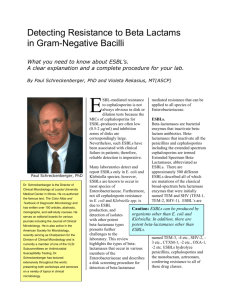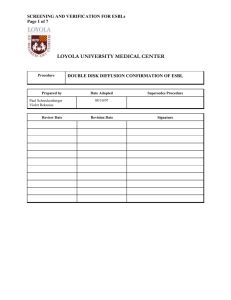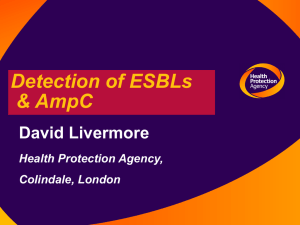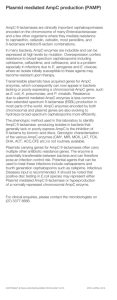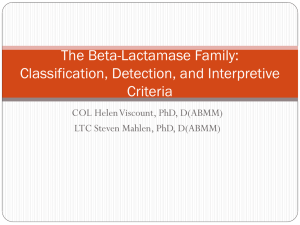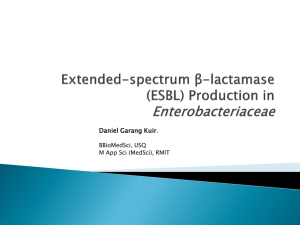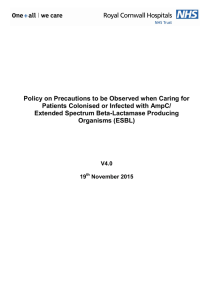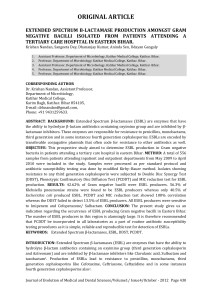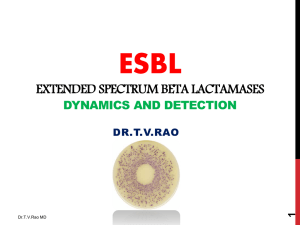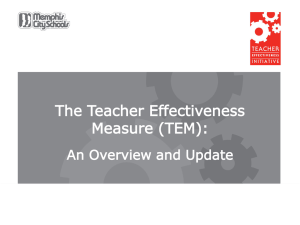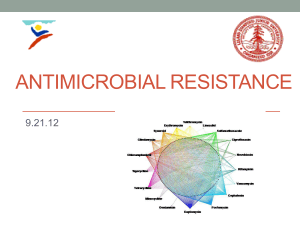Detection of beta-lactamase
advertisement
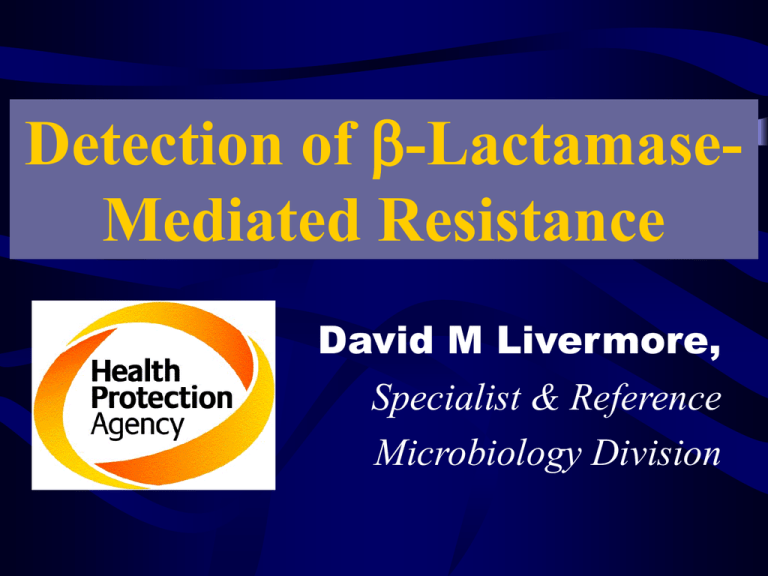
Detection of b-LactamaseMediated Resistance David M Livermore, Specialist & Reference Microbiology Division Action of a b-lactamase S H2O N O Inactive penicilloate COOH S Active penicillin HN O OH COOH b-Lactamase families A Staph penicillinase; TEM & SHV; chromosomal b-lactamases of Proteus, Klebsiella & Bacteroides B Zinc types C Chromosomal AmpC b-lactamases of most enterobacteria D OXA-class plasmid b-lactamases Established problems • Staphylococcal penicillinase • G-ve bacteria with penicillinases, TEM etc. • G-ve bacteria with AmpC enzymes • G-ve bacteria with TEM & SHV ESBLs Other types emerging... Emerging problems • Plasmid AmpC enzymes • ESBLs not derived from TEM & SHV • Carbapenemases • Resistance to inhibitor combinations Spread of TEM plasmid b-lactamases • 1963 Ampicillin; 1st broad spectrum penicillin • 1965 TEM b-lactamases in E. coli • 1969 TEM b -lactamase in P. aeruginosa • 1974 TEM in H. influenzae & N. gonorrhoeae • Now TEM in 30-60% E. coli & enterobacteria & in 5-20% of H. influenzae & gonococci b-Lactamase stable cephs a-methoxy, stability to TEM, SHV, ESBLs & Bacteroides enzymes H2 N S OCH3 N C S CONH N OR O Oxyimino-aminothiazolyl stability to classical TEM/SHV R COOH AmpC b-lactamases Derepressed Amt b-lactamase Basal in: • E. coli & shigellae Inducible in: • Enterobacter spp. • C. freundii • M. morganii • Serratia spp. • P. aeruginosa 2nd, 3rd gen cephs: • Labile, but weak inducers, select derepressed mutants Inducible [b -lactam] AmpC b-lactamases • Cephalosporins select derepressed mutants from inducible populations • Selection c. 20% in Enterobacter bacteraemia • 30-40% of all Enterobacter and C. freundii now derepressed at first isolation • Resistant to inhibitors; escaping to plasmids Extended-spectrum b-lactamases Activity vs. 3rd gen cephs TEM-1 1965 TEM-2 1970 TEM-3 1987 and now up to TEM-126…, also SHV-48 MICs (mg/L) for ESBL +ve E. coli R- TEM-1+ TEM-3+ TEM-10+ Ampicillin 2 1024 256 1024 Piperacillin 1 128 64 64 1 2 1 Pip + 4 mg/L taz 0.5 Ceftriaxone 0.03 0.03 64 2 Ceftazidime 0.12 0.12 32 128 Cefoxitin 4 4 8 4 Imipenem 0.12 0.12 0.12 0.12 Meropenem 0.03 0.03 0.03 0.03 Exotic ESBLs, not derived from TEM & SHV • CTX-M- 29 variants, some derived from chromosomal b-lactamase of K. ascorbata – PER- PER-1 in Turkey; PER-2 in Argentina – ESBL OXA-2 & -10 mutants- mostly P. aeruginosa Turkey CTX-M b-lactamases • Escaped from the chromosomes of Kluyvera spp. • More active vs. cefotaxime than ceftazidime – But mutation can confer ceftazidimase activity • Predominant ESBLs in Argentina since 1990 • Disseminating rapidly in Asia & Europe – 2003 ICAAC full of poster on ‘First CTX-M from ....’ Activity of CTX-M2 Vmax Km (%) (mM) Cephaloridine MIC MIC + R R (mg/L) (mg/L) - 100 - Piperacillin - - 1 1024 Cefotaxime 12.5 70 0.06 16 Ceftazidime 0.02 203 0.13 2 0 - 0.03 0.03 Imipenem Bauernfeind et al., 1992 Infection 20, 158 CTX-M in the UK • 2000- First producers – K. oxytoca, Leeds,CTX-M-9 • 2001/2- First hospital outbreak – B’ham, 33 patients, K. pneumoniae, CTX-M-25 • 2003- Community E. coli from UTIs – Diverse strains & locales, 2 CTX-M variants Brenwald JAC 2003, 51, 195; Alobwede JAC 2003, 51, 470: HPA data on file Acquired carbapenemases rare • BUT…. • IMP & VIM metallo-enzymes increasing, • OXA carbapenemases in Acinetobacter spp.; • Few class A types…. KPC, IMI, SME• Few major outbreaks of producers VIM & IMP metallo-blactamases • IMP, 16 types; VIM, 12 types; SPM-1 – 15% variation in families; 70% between them • Hydrolyse b-lactams except monobactams; inhibited by EDTA, not clav or sulphones • Mostly Far East & S. Europe- few UK isolates – Mostly P. aeruginosa; 2 Acinetobacter; 2 Klebsiella • Not all gene +ve isolates are obviously R MICs (mg/L) for E. cloacae with metallo-b-lactamases MEM IMP AZT CTX CTZ CFM R947 Y580 T524 N947 C. freundii IMP-8 TEM-1 IMP-8 TEM-1 IMP-8 TEM-1 VIM-2 1 2 0.03 >256 >256 32 0.5 2 0.02 16 128 32 1 4 0.03 32 >256 32 0.5 1 0.06 32 64 16 Yan et al., JAC 2002, 50, 503 b-Lactamase detection • Nitrocefin- very sensitive, expensive, good for fastidious GNB & Moraxella, not staph • Acidimetric -sensitive, care with controls to avoid false +ve • Iodometric -sensitive, fiddly, care with controls to avoid false +ve • Microbiological -v. sensitive, slow Challenges for the diagnostic lab • Detection…. Haemophilus, Neisseria etc. • Predicting b-lactamase types. Have GNB got ?: ESBL, AmpC Metallo types, VIM, IMP etc… • Spotting unusual patterns; knowing what to refer Some useful knowledge TEM ESBL CTX-M K1 Ceftazidime AmpC Hi-level R R v S Cefotaxime R v R S Cefoxitin R S S S Aztreonam R v v R Synergy + clav No +++ +++ No Know the species ESBLs: times a’ changing with CTX-M • Old advice- test ceftazidime; ESBL test if R • New advice- test ceftazidime & cefotaxime; ESBL test if R to either • Alternative- test cefpodoxime; ESBL test if R • Still true- Only testing cefuroxime is inadequate ESBL detection • Double disc synergy • Combination discs • E-test – Test potentiation of ceftazidime, cefotaxime or cefpodoxime by clavulanate…… – Use whichever suggested ESBL production Detection of ESBLs with combination discs (MAST) +ve result, zone enlarged 50% Discs (30+10 mg) % Detected (n =100) Ceftazidime +/- clav 88 Cefotaxime +/- clav 66 Both 93 M’Zali et al. 2000, JAC, 45, 881 Zone differences (mm), Klebsiella & E. coli c’pod/clav 10+1 mg minus c’pod 10 mg 60 Control AmpC K1 ESBL CTX-M 50 40 30 20 10 0 -3 -1 1 3 5 7 9 11 13 15 17 19 21 23 25 Etest for ESBLs Cefotaxime Cefotaxime + clavulanate Etest for ESBLs Cefotaxime Cefotaxime + clavulanate Difficulties in ESBL detection • Ceph R Enterobacter etc. most likely AmpC derepressed ….. But may have ESBL • Clav induces AmpC; hides ESBL inhibition – Try to read anyway – Suspect ESBL if pip/taz or cefotetan S – Synergy test between cefepime & clav Bacteria not to test for ESBLs • Acinetobacters – Acinetobacters often S to clavulanate alone • S. maltophilia – You get +ve results via inhibition of L-2 chromosomal b-lactamase, which is ubiquitous in the species AmpC inducibility- when to look • Rarely!!!!! • Risk is mutation, not inducibility per se • Best to identify & predict risk from species • Biggest risk Enterobacter & C freundii • Avoid cephalosporins against them Identify means identify TO SPECIES LEVEL all Enterobacteriaceae (‘coliforms’) ex serious infections AmpC & ESBLs- what to refer to ARMRL • E. coli & Klebsiella suspected of AmpC – ? Have plasmid types ? Recent travel • ESBL +ves from community – ? CTX-M types • Enterobacters suspected of having ESBLs Double disc antagonism for inducible AmpC Cefoxitin Ceftazidime Cheapskate’s insurance vs. lawyers for AmpC derepression • Test cefoxitin • Enterobacter & C. freundii with inducible AmpC are clearly R • M. morganii & Serratia aren’t R; but carry lower derepression risk • Species without inducible AmpC are S ARMRL recommendations for carbapenem R isolates • Enterobacteriaceae & Acinetobacter – Send in to ARMRL – Except Proteeae weakly R to imipenem only • P. aeruginosa – Screen with EDTA synergy test – Send to ARMRL if +ve S. maltophilia…. Please DON’T send Etest for metallo-b-lactamase Imipenem Imipenem + EDTA Etest for metallo-b-lactamase Imipenem Imipenem + EDTA Carbapenem R isolates at ARMRL • Screened with imipenem/EDTA Etest • Spectrophotometry with imipenem • PCR for carbapenemase genes • DNA sequencing Weaknesses of strategy • False positives with Etest MBL tests – 9/23 MBL Etest+ve P. aeruginosa hydrolysis -ve & negative for blaIMP & blaVIM • Class D b-lactamases v. weak activity – Difficult to detect hydrolysis • Sometimes you wouldn’t guess to look! Why false +ves with Etest MBL? • EDTA may permeabilise the outer membrane • Zinc suppresses OprD in P. aeruginosa, inducing imipenem resistance1 So?? lack of zinc may induce OprD. Sensitising the bug?? • Zinc inactivates imipenem!2 1Carmen-Conjeho et al., ECCMID, 2003 2 Baxter & Lambert JAC 1997, 39, 838 Activity of pip/tazo vs. ESBL +ve klebsiellae; 1994 & 1997/8 50 % of ESBL producers 1994 1997/8 40 30 20 10 0 0.5 1 2 4 8 16 32 64 128 256 512 1024 MIC (mg/L) The message • Beta-lactamases are getting more complex • Full I/D needs complex molecular methods Much can be inferred from simple tests. Needs I/D Testing wide panels of antibiotics; synergy tests Knowledge of what’s unusual
